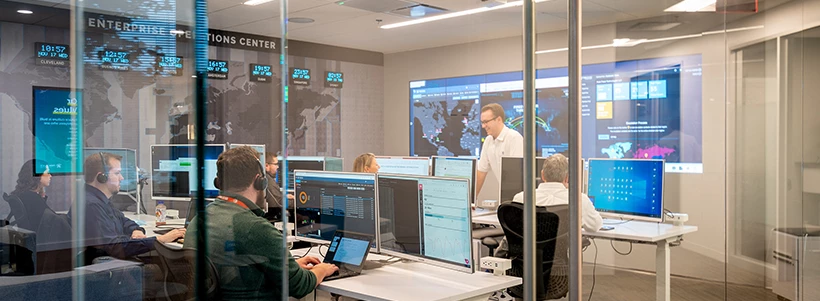What Is Server Management for Physical and Virtual Servers?
ParkView Managed Services
Managing large groups of servers across multiple locations isn’t for the faint hearted. IT Managers are under constant availability, budgetary and performance scrutiny as servers sit at the heart of everything IT. Fail in any part of server management, and your organization will be negatively impacted by slow performance, downtime, possible data loss, and become vulnerable to cyber breaches. The stakes are high.
But are you managing too many servers? Is now the time to virtualize or consolidate servers? Are there new considerations that have altered the server game plan? We take a fresh look at how best to manage your servers in 2022.
Jump-to Section
Importance of Server Management
Physical Sever vs. Virtual Server?
Key Components of Enterprise Server Management and Administration
1. IT Server Deployment and Configuration
2. Hardware Monitoring and Management
3. Software Monitoring and Management
What Is Server Management?
Server management includes the ongoing monitoring and maintenance of servers to ensure they operate at optimal performance levels. Understanding how to manage servers doesn’t stop at physical server management. It equally applies to the ongoing management of software, security, and backup systems and the same principles apply equally to physical server as they do virtual servers (or VMs).
Tackling server management is about controlling your servers effectively in order to apply administrative or maintenance operations. This starts with server monitoring to help improve and optimize performance. Further, there are countless activities to conduct including updates, new setups, monitoring, optimization, capacity planning and alerting when things aren’t going to plan.
If your internal resources of have been stretched thin lately, explore how IT server management services can act as a force multiplier for your IT team. Managed services like ParkView Server Management™ can help increase efficiencies and operational effectiveness while freeing up your team for more strategic initiatives.
Importance of Server Management
The server monitoring and management process is Tier 1 activity that all businesses strive to get right. Organizations totally depend on their server infrastructure for pretty much all their essential IT functions, including data storage, application hosting, emails, and trading applications. Without servers – offsite, onsite, physical, or virtual – critical business processes just can’t occur.

Physical Sever vs. Virtual Server?
Understanding the difference between physical server and virtual servers will help clarify what type of processes you need. Today, through data center virtualization, the functions of previously individual physical servers can now be reduced into a smaller hardware footprint by the creation of multiple virtual servers hosted on just one physical server. This consolidated approach carries compelling cost, space, environmental and flexibility advantages.
So, why isn’t every server created virtual? Often large virtual server farms can be complex to manage and some companies prefer dedicated, latest generation hardware to run their top critical applications. Secondly, virtual servers can’t exist without at least one physical machine to support their operation.
So, the long debate between dedicated physical server vs. virtual server rolls on. Regardless, the server management principles across both approaches follow the same basic principles.
Key Components of Enterprise Server Management and Administration
Given the importance of server management on all business operations, a solid next step is to circle back and review how you manage servers to avoid system failures. Even if you think you have a watertight server management policy in place, server sprawl can happen quickly, so set periodic review points.
There are 5 areas to check (and recheck) that will lead your organization toward a path of optimal server management and administration.
1. IT Server Deployment and Configuration
Whether you’re undergoing a server refresh or starting from scratch, correct planning, deployment, and configuration for enterprise server management is essential. When you are dealing with large-scale or multi-site implementation of servers, or large refresh projects that span across data centers, offices, retail stores, warehouses and manufacturing environments, it’s better that you seek our IT deployment services from a trusted provider.
Park Place Technologies offers IT Deployment Services for occasions where large-scale or multi-site implementation of servers across data centers or corporate server rooms. Our deployment services can be leveraged for several projects, such as technology refreshes or implementing new hardware across the globe.
The goal of this type of solution is to create a best-in-class server management approach that relieves your overburdened team of physical and virtual server set up responsibilities. Migrating physical servers into a virtual server environment has several involved steps. For example, a hypervisor needs deployed first to oversee the sharing of the physical server resources to create and run virtual machines, all of which still need their own resources tailored like CPU, RAM and storage types.
Given the VMs are independent of each other – and they run their own applications and operating systems – greater thought must be given to virtual server security and disaster recovery planning, alongside identifying likely performance bottlenecks.

2. Hardware Monitoring and Management
This is where remote hardware monitoring comes into play, identifying unstable performance before it impacts server productivity. Keeping your hardware performing 24×7 is a mainstay of server management support. To do so, hardware needs continuous management with focus on monitoring the following components of servers:
- CPUs should be constantly monitored to avoid overuse
- Random Access Memory (RAM) may need supplementing
- Server Hard Drives shouldn’t reach maximum capacity
- CPU shouldn’t exceed temperature range as overheating can cause permanent damage.
3. Software Monitoring and Management
Another server management best practice is the ongoing monitoring of your server software. This should be done regularly to identify and execute maintenance and patches. According to Computerworld, Microsoft alone released over 16 major releases and patches in 2021 for increased security and performance, proving that Patch Tuesdays have never been busier!
OS patching, OS version updates, OS remediation and Firmware updates all figure centrally in software monitoring – and must be deployed across multiple operating systems and hypervisors.
4. Server Security Management
Server security is another critical component that causes endless worry for IT Managers. We’ve established that servers hold a great deal of an organization’s vital information and therefore require the highest degree of caution in maintaining a secure server network. Key considerations will be: –
- Installing anti-virus software
- Adding firewalls
- Increasing password security policies
- Considering encryption for sensitive data
- Installing a monitor and remediation notification tool to isolate suspicious activity
5. Backup & Recovery Management
Should things go wrong through human errors, hacks, attacks, system failures and data loss, installing regular and reliable server backup windows are the essential final component of any server strategy. Robust solutions for server backup software have been available for over twenty years allowing seamless rollbacks and include backup for virtual and physical servers. Having watertight backups in place will also help you reach Disaster Recovery and regulatory planning responsibilities.
How to Manage Servers – In-house vs Third Party
Fortunately the pressure of achieving always-on, high-performance server systems which flag and predict network failures and hardware problems is a process that can now be reliably shared through selection of the right infrastructure managed services partner.
Enterprise organizations need to carefully consider the associated overhead costs and choose to manage servers internally, externally via a management company, or apply a mix of both.
If you decide to transfer the onus of server management, you can now do that through ParkView Managed Services™, Park Place Technologies’ suite of services that proactively eliminates server downtime while you focus on the next stage of your digital enrichment. Contact us today to learn more!



